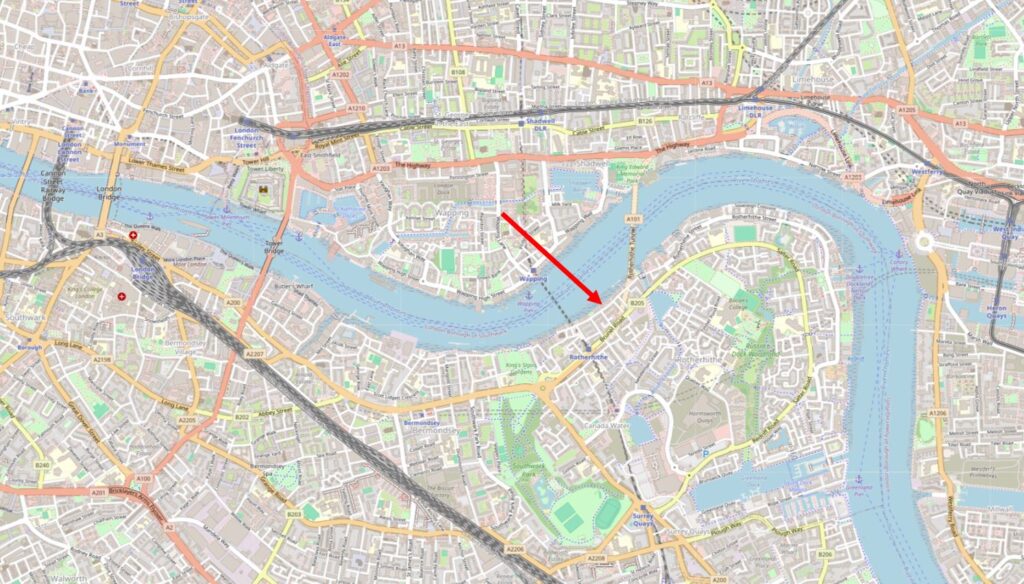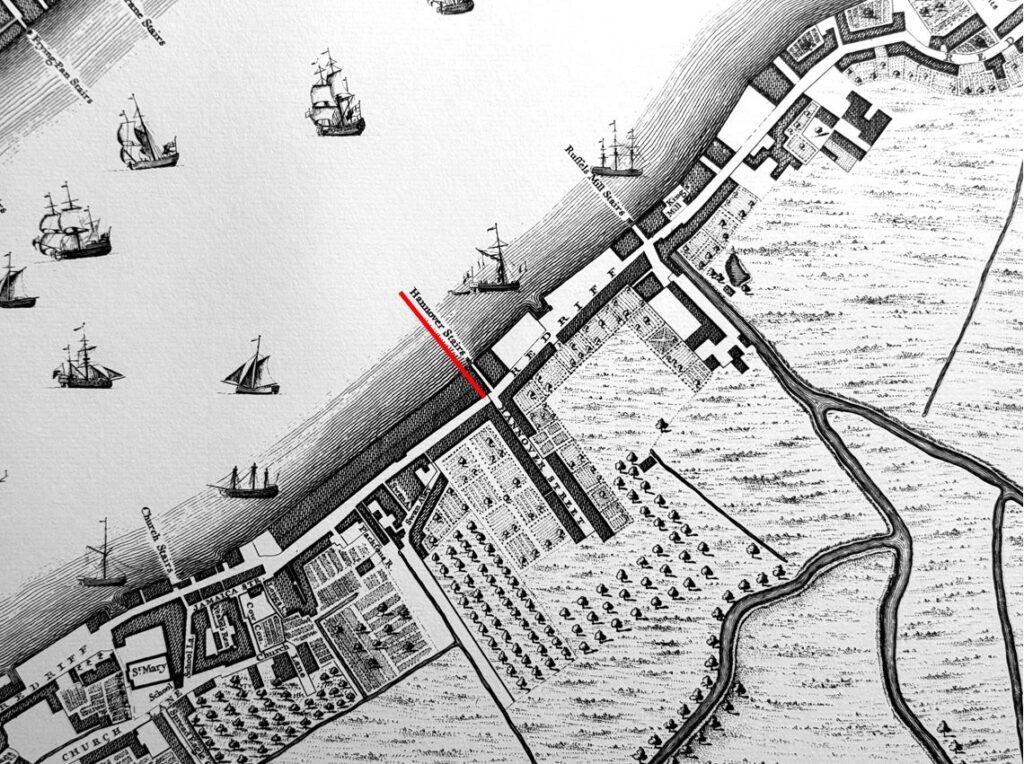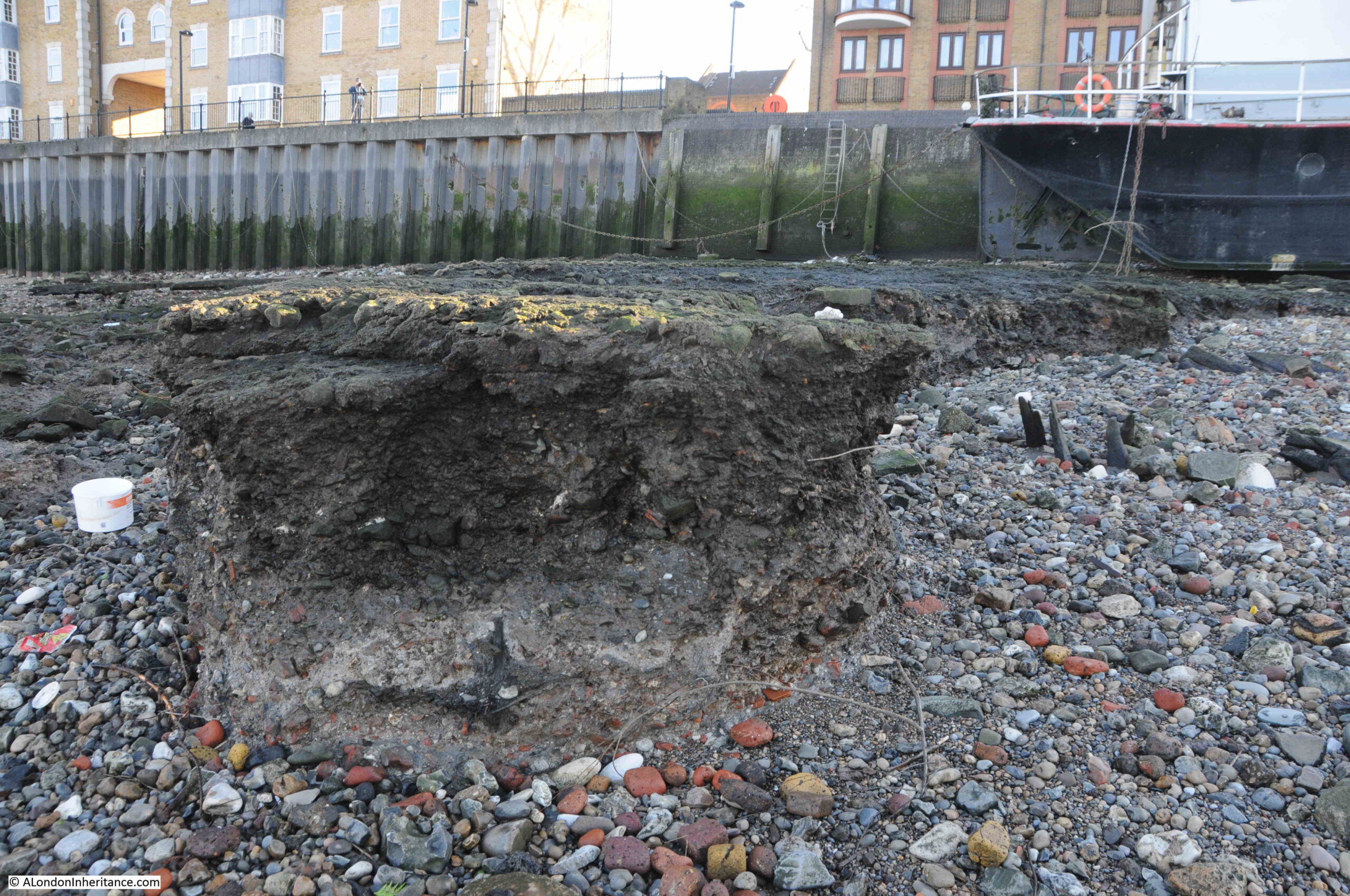For this week’s post, I am continuing with one of my favourite London subjects – Thames Stairs, and I am in Rotherhithe to find Hanover Stairs, and also to check whether the stairs confirm my theory that nearly every Thames stair had an associated pub.
This was the view, early on a sunny morning, walking along the footpath beside the Thames, with Hanover Stairs signposted next to the steps down to the river:

There is a gate at the top of the stairs, with a warning sign showing someone falling down the stairs, along with the danger warnings of Slippery Steps, Sudden Drop and Deep Water – all of which make sense for these stairs:

A look down the stairs reveals that they are in very good condition and consist of brick steps leading down to a sandy foreshore:

The Port of London Authority list of access points to the River Thames has very little information about these stairs. It just states that they were in use in 1977, consisted of concrete stairs and were in good condition.
Hanover Stairs are in Rotherhithe, and I have marked their location with the red arrow in the following map (© OpenStreetMap contributors):

Hanover Stairs are rather unusual in that there is a ship moored at the foot of the stairs. A scene that was probably rather common when the river was in use and ships would have moored in the river and along the foreshore.

Presumably a house boat, and equipped for permanent occupation as there are a range of pipes plumping in services between the ship and the shore.
During my visit it was a low tide and I could walk out for a reasonable distance across the foreshore. In the following photo, I am looking back from the water’s edge to the shore line, and the photo shows how the shore here drops considerably away from the edge of the land:

Looking east, with Shadwell and Limehouse visible across the river:

On the right of the photo, just along the foreshore from Hanover Stairs, is the jetty that once served Rotherhithe Gas Works, which I explored in this post.
Looking across to Wapping on the northern shore of the river, and we can see New Crane Wharf:

There is a gap to the left of New Crane Wharf. This gap is to allow access for another set of Thames Stairs – New Crane Stairs, which I wrote about in this post.
The narrow gap for New Crane Stairs, between two large buildings, shows the importance and persistence of Thames Stairs.
The following photo is looking west along the river, and in this photo we can clearly see how steep is the drop in the foreshore from the edge of the river out towards the centre:

I have marked the location of Hanover Stairs with a red arrow in the following extract from the 1894 edition of the Ordnance Survey map (‘Reproduced with the permission of the National Library of Scotland“):

Next to the stairs, where the house boat is today, there was a small pier. On the foreshore, there is the abbreviation M.P.s – This stands for mooring posts and shows that ships and boats would have been moored along the foreshore at Hanover Stairs.
Large buildings line the river, warehouses and industrial sites, with a small number of terrace streets leading back in land.
To the upper right of the above map, is the pier for the Rotherhithe Gas Works, and these works can be seen running back in land, where the circular feature of the gas storage tanks can be seen.
I have a theory that nearly all Thames Stairs in populated and industrial areas, had a pub located next to the stairs, and Hanover Stairs continues to confirm this theory.
In the above map, I have ringed the PH of Public House which was opposite the stairs, where an alley led between two adjacent large buildings, down to the stairs.
I found the name of the pub by doing a newspaper search for Hanover Stairs, and found the pub had a good Thames related name of the Ship.
A typical example of where the Ship was mentioned in relation to the stairs, and an advert which shows how these pub were important for more than just drinking is the following advert which appeared in the Kentish Independent on the 24th of January, 1852, where an auction was being advertised for the “Stock of Mr. Little, Timber Dealer, who is retiring from business”.
The auction of Mr. Little’s stock included a very large quantity of timber, a “capital nearly new Timber Cart”, and rather strangely “a Sow and Four Pigs”.
The advert then goes on to list where the catalogue for the auction could be had, and this is where I found the reference to the Ship:
“Catalogues had: the Lord Duncan and Dover Castle, Broadway; Bratt’s New Cross Inn: Shard’s Arms, Old Kent Road: The Ship, Hanover Stairs, Rotherhithe; Prince of Orange, Greenwich; Three Tuns, Blackheath: Tiger’s Head, Lee: Dartmouth Arms, Sydenham Common; of Mr. Little on the premises, and of Mr. Rogers, Auctioneer, Valuer, Estate and House Agent, Lewisham.”
Another advert which mentions the pub was from June 1825 shows the type of excursion you could have taken on a summer’s day, early in the 19th century:
“GRAND NOVEL EXCURSION. A. READ, Captain of the FAVOURITE, Steam Packet, begs to inform his Friends and the Public that he has engaged the above elegant and commodious Vessel for an EXCURSION round the ISLE of SHEPPY, passing the Nore, Whitstable, Queenborough, and his Majesty’s Fleet at Sheerness, on Thursday, the 29th Instant, and return the same evening. A grand Band of Music will be provided. refreshments may be had on board at the usual moderate charges.”
Tickets for this “Grand Novel Excursion” were 5 shillings and 6 pence each, and the Ship was one of the places where you could buy tickets, and in this advert, Mr. Rounce was mentioned as the landlord of the Ship. Tickets were for sale widely across London, from the Rose by the Old Bailey, pubs in east London, both north and south of the river, a grocer in Tower Street, and offices in Fenchurch Street.
Both of these adverts show the importance of these local pubs to other commercial activities. They were places where you could advertise to the local community and use as local distribution hubs.
The importance of the relationship between the Ship and Hanover Stairs is that in these two examples, and many other reference I found, although the pub is in the street opposite the stairs, the name of the street is not mentioned, just the name of the pub and the name of the stairs.
The Ship closed around 1960, and sadly I cannot find any photos of the pub.
The majority of the Thames Stairs have lost their associated pub. A few still exist in Wapping (Pelican Stairs next to the Prospect of Whitby and Wapping Old Stairs next to the Town of Ramsgate).
In Rotherhithe, a surviving example is the Mayflower, where to the left of the pub can be found Church Stairs:

21st century detritus washing up on the foreshore at Hanover Stairs:

The earliest written references I could find to Hanover Stairs dates from the 1790s, where for example, on the 11th of January, 1796, in a list of Dividends to be paid to Creditors, there was the following “Alexander Christall and James Church of Hanover Stairs, Rotherhithe, Surrey, Sail-makers”.
On the 28th of November, 1761, it was reported that “The John and Thomas, Blickenden, loaded with Corn, is sunk in the River near Hanover Stairs”.
Hanover Stairs can be seen in Rocque’s map of 1746 (underlined in red):

The map shows that in the 1740s, whilst the river’s edge was developed, a short distance inland it was still orchards, farmland, fields, marsh and streams. The section of the road that is now Rotherhithe Street was then named Redriff.
One of the few streets that leads inland from Redriff is directly opposite Hanover Stairs, and is named Hanover Street. I suspect the street took the name from the stairs, as these were probably a much older feature than the street.
I cannot find the source of the name Hanover as used for the stairs. Possibly there may have been local merchants from Hanover in Germany, of it may have been after George I, who became the first British King from the German House of Hanover who was on the British throne between 1714 and 1727.
Hanover Street changed named to Heston Street, and in the rebuilding of the area over the last few decades, the street that was one of the first running inland from the river, was built over and is now one of the many lost streets of the area.
So the stairs along the foreshore have been here for at least 275 years, and features from the long industrial history of the area can still be seen along the foreshore, for example, large stretches of consolidated stone and concrete, much eroded by the river:

Looking along the foreshore from Hanover Stairs to the pier that once supplied the Rotherhithe Gas Works with coal arriving along the river:

Looking back at the steps of the stairs, with in the foreground some of the chains and weights used to keep the house boat securely moored alongside the river wall:

Cables and pipes carrying services to the house boat and tyres to protect the side of the boat:

There are frequent mentions of Hanover Stairs in newspapers up to the 1930s, when the last two reports are about an 11 year old boy who drowned after falling into the river when he and his friends were playing on barges next to the stairs, and a thief who was caught in Rotherhithe Street with a sack full of Gin bottles, which had been stolen from a barge lying next to the stairs.
After the 1930s, there seems to have been very little happening at the stairs (or at least anything that was considered newsworthy). That may have been due to the level of bomb damage at the stairs and the surrounding streets, which was considerable.
After leaving the stairs, I walked along the river path to take a closer look at the former gas works pier:

The pier is in good condition, and is a suitable reminder of the connection between the river and the industries activities that once occupied so much of Rotherhithe:

I have often wondered what the metal structure is on the rivers edge at the centre of the pier, shown in the photos above and below. I assume it is part of the equipment which once carried coal from ships moored alongside the pier to the gas works, however now standing isolated of any other infrastructure, it almost looks like a work of art.
Seen from head on, the curves of the shaped metal on either side almost give the whole thing the appearance of a bird flying in from the river:

Another set of Thames Stairs ticked off the list, and one that continues the link between a local pub and stairs.
They were an important combination in the day to day life of the working river. The stairs provided access to the river and the barges and ships moored nearby, the watermen that would take you to your destination along the river, a place where those working or travelling on or along the river would have known well.
The stairs were also a landmark, referenced whenever you needed to refer to something happening on the river, on land, or to get to this part of Rotherhithe.
The pub was not just a place to buy alcohol, it was an important part of the local community, a place where other commercial activities could take place, such as selling tickets or distributing auction catalogues, where inquests to those who died on the river were held, where those working on the river probably went in for a drink after returning via the stairs, a local meeting point next to the stairs etc.
And that relationship is strengthened by the names frequently given to these pubs, which often referred to some aspect of river life, as with the Ship next to Hanover Stairs.

I love reading your articles on a Sunday morning,many thanks.
Although I have no evidence I believe the metal structure on the pier is in fact a commissioned work of art. Carefully looking at its fabrication and the fact that it is over structured as well as its form makes it unlikely to be a functional structure. Presumably the local authority or the the PLA could confirm this.
Another remarkable piece of research.
I was in the area last week as my son is currently living just off Brunel Road. I will make a visit to these stairs next time we meet. It’s a shame the Ship is no longer there. Judging how popular the Mayflower and Angel pubs are, I’m sure it would have been commercially viable today.
The structure looks very much like art work to me and resembles very closely a boiler’s gas burner. Could they have commissioned a sculpture in the form of something that most people would have burning gas in their homes?
You mention The Ship PH which closed in 1960. At the junction of St Marychurch Street and Elephant Lane, only 100m or so away from the Mayflower PH is … The Ship PH. (One of my top three favourite London boozers) it is notable for being the last London PH to be completed before the outbreak of WWII – and, as a result, and although it’s not large, it is a wonderful example of 30s architecture. I wonder why it takes the same name?
I spent many a happy lunch break and after work in the Ship and wondered the same.
The area of foreshore in front of and to the left of Hanover Stairs is actually quite sandy, and on fine days attracts picnickers and sunbathers: it is known as ‘Rotherhithe Beach’
If anyone is interested by sheer serendipity the houseboat at the bottom of Hanover Stairs is FOR SALE!
https://www.onthemarket.com/details/13850251/
Excellent, I’ve develop a fascination for the stairs myself and recognise their importance to the capital and the society using them and living nearby. As always a brilliant post
It was sad to read about the 11 year old boy who drowned in the 1930s. Living nearby we were often mucking about on the barges and whilst we were jumping from barge to barge near Cherry Garden Pier one day my friend fell in and drowned.This was 1965 and we were both 8 years of age. I remember vividly the headmaster speaking about this tragic accident and 2 River Police officers came to our school and told us how dangerous the river was.
How awful for you too! Best to let that memory GO. Take care.
Studying maps, I think you are right about the relationship between the stairs and pubs – in most cases, a drink is just a few steps away or across the road. Rowing is thirsty work. If you type Neston Street into the London Picture Archive, there are a couple of photos of the street but at the other end and you can’t make out a pub at the top of the street as it is just out of shot.
Super read and lovely photos to match
Really very interesting commentaries on a fantastic number of topics that I have been enjoying immensely! Thank you for these very timely publications to which look forward. I notice the map spells Hanover with two n(s). Is there an explanation for the change! Thanks again. Tedd from Baldwin, Maryland, USA.
I love how your posts read. I agree the metal work on the gas works jetty do look like a bird taking off from the river. I used to work for the London Bubble Theatre co. and drank in The Ship on Elephant Lane, it is not near the steps but at least there is still a pub called the The Ship sort of near. You mentioned Pubs being places of social and community events as well as places to drink. On Portland the Cove has in its time been a makeshift morgue, housing the drowned from ship wrecks, I am sure many pubs along our coast line have been used this way. I’m going off on a bit of a tangent here, yesterday we were leaving a Pub called The Britannia (on Portland) and witnessed a car accident involving two vehicles, it reduced the only road to the top of the island to one lane, the landlord of the pub jumped into action and directed the traffic, showing that pub landlords are still carrying out community duties (even after the police arrived who were not so good at it!) As I say bit of a tangent but I feel London and Portland are connected through stone.
Have just returned from a trip to Rotherhithe and Hanover Stairs today.. these ran down between two wharves, Ransoms wharf to the east side and Carolina wharf to the west. Both wharves were owned by our ancestors, Lucy Talbot and sons bargebuilders. Pop that into a Google search and you will find an image of them. Working building barges on the foreshore at the bottom on the steps
Update! I have found a photo of the ship pub, posted to Flickr by Bermondsey boy… search ship inn, Neston Street. I sent a screengrab to you via instagram
Brilliant, thanks